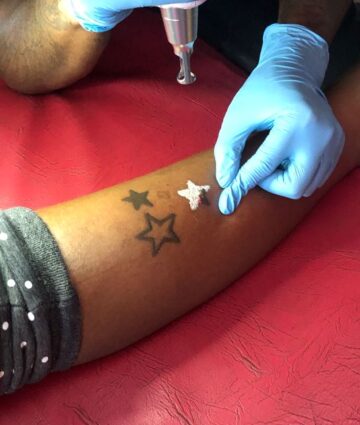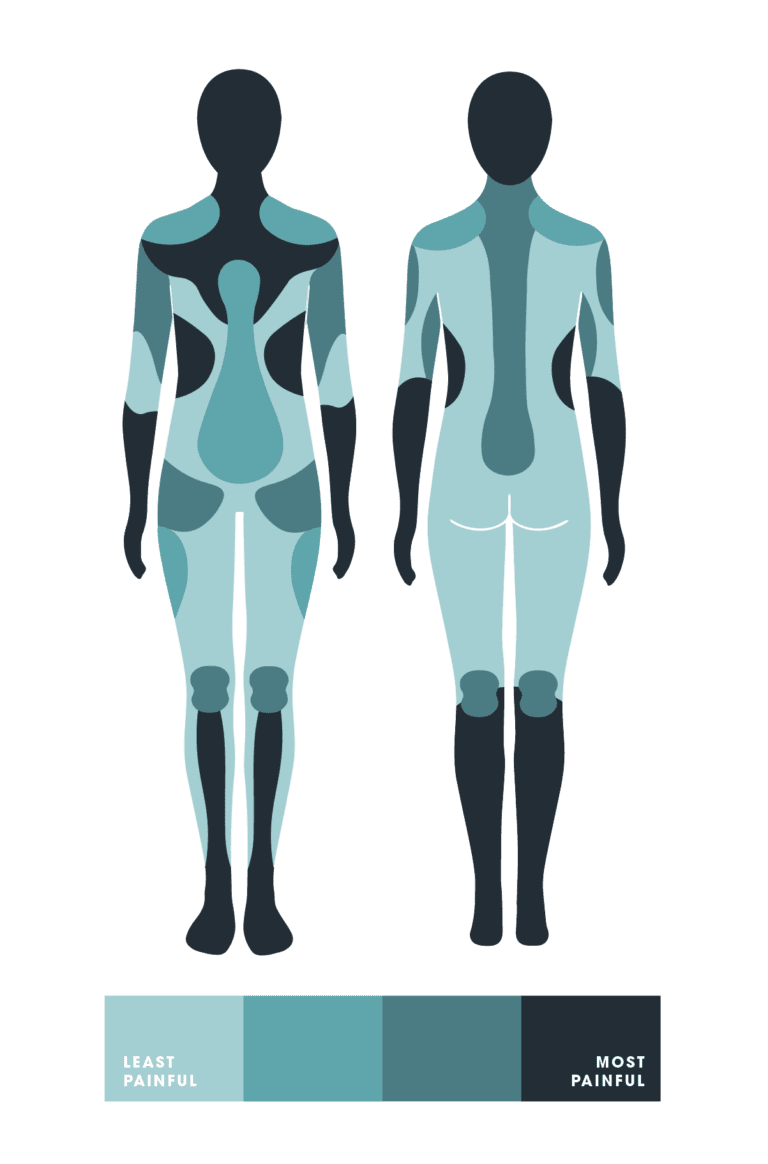How Laser Tattoo Removal Works
You must first understand the process of getting a tattoo in order to understand how it might be removed. The inner layer of skin, the dermis, gets ink during the tattooing process. Once tattoo ink is logged into the middle layer of your skin, your body’s immune system sends white blood cells to the tattooed area to pull out as many ink particles as possible. The tattoo design is left behind when larger particles that the cells were unable to break down are left behind.
These cells gradually break down the bigger particles, which results in natural fading. Because the body’s immune system detects tattoo ink as a foreign substance and makes an effort to eliminate ink particles, tattoos naturally fade over time.
Laser Tattoo Removal Process
During a laser tattoo removal procedure, your practitioner guides a laser over the area of the tattoo. Tattoo removal lasers emit pulses of light energy instead of a continuous beam of light like a laser pointer does.

Schedule Appointment
The energy is absorbed by the tattoo ink particles, which heat up and break into minuscule pieces. The body’s immune system then removes tattoo ink particles from the area throughout the weeks that follow therapy, softening the appearance of the tattoo. The tattoo ink is gradually destroyed by the laser treatments, until none is left.
When tattoo removal laser light is applied to the skin, it heats up and shatters the ink that it reaches first within the skin. In other words, the shallowest layers of ink are removed before the deepest layers.
It takes multiple treatments to penetrate through all of the varying depths of ink in a tattoo. If a tattoo is particularly dark or bold, it will require more treatments to remove the ink compared to shaded tattoos with a lower density of ink
Letting the Body Do Its Work
Tattoo removal is not a quick treatment; it typically takes people several months to complete. To completely remove a tattoo, you typically need between 5 and 10 sessions, spaced at least 6 weeks apart. Patients frequently ask why there are so many treatments needed to remove tattoos, as well as why there is a recovery period. In order to give an informed patient consultation, it is crucial for practitioners to be aware of the answers to these questions.
Because not all of the tattoo ink can be broken up during a single treatment session, laser tattoo removal needs multiple sessions. The ink is injected into the dermis at various depths during tattoo application. The shallowest layers of ink in the dermis absorb the energy from the laser light and disintegrate, but the deeper layers may not be impacted. The deeper layers of ink can only be handled once the body has removed the topmost layers of ink. In effect, every successive tattoo removal treatment affects deeper and deeper layers of ink until none remains.
Because it takes time for the body to remove the broken tattoo ink from the tattoo’s spot, patients must wait between treatments. Immune system phagocytic cells eventually transport the ink particles to the lymph nodes, where the pigments are still present, as part of the flushing process. The best results from each treatment come from waiting as long as possible between sessions because the body can only remove the ink at a particular rate. Additionally, the waiting period allows any blisters or scabs to heal, lowering the risk of over-treating the area and resulting in unintended side effects.
What factors influence Tattoo Removal?
General health
Your immune system prioritizes healing chronic illnesses and being ill. This may slow down how quickly the ink is washed off of your skin.
Location of tattoo
Tattoos that are closer to the circulatory system and in places with high blood flow can be removed more quickly.
Colour of ink
The effectiveness of the removal depends on the colour of your ink and your skin tone.
Lifestyle
Your body’s capacity to eliminate the ink might be hampered by leading an unhealthy lifestyle, such as smoking or vaping, and by exposing the treated area to direct sunlight.
Age
Your immune system and metabolism both decline with aging. Immune systems that are younger or more active will clear ink more quickly.
Skin Color
Your skin tone may influence the results of laser removal and the laser settings that your specialist uses.
What to expect during your appointment for laser tattoo removal
You’ll have a consultation before your first session to see if your tattoo is a good candidate for removal, and we’ll talk about reasonable expectations and potential outcomes. You will be provided a text number for a prompt response for any queries or concerns throughout the procedure, as well as details about the approximate treatment time, the intervals between sessions, post-care of the treated area, and the process itself. You can call this number at any time of day or night, including on holidays.
We will rapidly go over everything that was covered in the meeting when you come in for your first session, which is often the same day as your initial visit. Most procedures last only a few seconds. Aquaphor will be applied to the treated region, and a bandage will be placed over it.
Does laser tattoo removal hurt?
It can be extremely painful to have a tattoo removed, often more so than getting a tattoo in the first place. To break down the ink particles, the lasers heat them to thousands of degrees, but because it happens quickly and in a small space, the energy instead collapses into a shockwave.
This shockwave causes the upper layer of skin to lift up and appear white, or to “frost,” as it vibrates through the skin. This impact, however momentarily unpleasant, typically only lasts a few seconds.
The discomfort of laser tattoo removal can be managed. Rebel Inks Tattoo does not provide topical numbing creams or local anesthetic (which most find to be ineffective when treating tattoos). Instead, we choose the Cryo 6 Cool Air Device, a cooling system. With a stream of 30°C cold air, this system lessens pain. Air cooling also lessens thermal injury while promoting speedy healing.
You might have some swelling, sensitivity, and mild pain, comparable to a sunburn, as the tattoo area heals. Aftercare procedures for laser tattoo removal might lessen discomfort.

Laser tattoo removal aftercare
Your tattoo specialist gives you particular advice when you get your tattoo to make sure that it heals properly and looks fantastic. Similar to surgical procedures, laser tattoo removal relies on appropriate aftercare to ensure healthy healing and superior outcomes.
Keep the area tidy, moist, and covered with a sterile dressing following your procedure.
Choosing a specialist for laser tattoo removal
The most crucial element of any tattoo removal procedure is expertise, technology, personnel, honesty, and individualized care. Anyone you choose to perform your laser tattoo removal procedure should put your comfort and the best results first. Make sure the specialists at the location you’ve chosen can respond to any of your inquiries and offer tailored advice for your particular tattoo.
At Rebel Inks Tattoo, we believe that your laser tattoo removal specialist should be just that: completely specialized. While visiting a medspa or skin treatment centre may sound enticing, laser tattoo removal is frequently not their area of expertise, so you won’t receive the best results.
OUR LOCATION
Areas We Serve
NAIROBI
KIAMBU
KAJIADO
MACHAKOS

